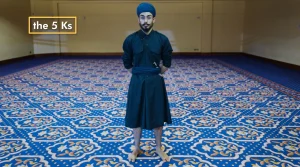Holy Cribs: The Gurdwara
Arvinda Singh, a young Sikh, gives TrueTube a tour of his Gurdwara, the Sri Guru Singh Sabha in Southall. He shows us the prayer hall, the dining hall and even the Guru Granth Sahib’s bedroom!
Curriculum Mapping
Transcript
Holy Cribs: Gurdwara
Arvinda: Sat sri akal ji! Welcome to Sri Guru Singh Sabha Southall! My name is Arvinda Singh and I'm a Sikh. Our religion is often called Sikhism, but we like to call it Sikhi. This is the Gurdwara. This is our holy building where we come to worship Waheguru, which is the name of God. I'm going to give you a tour now. Just before we go inside, I want to show you the Nishan Sahib. This is a special flag in front of every Gurdwara. This is usually yellow or orange in colour and has a blue symbol on it called the Khanda.
Right then. Come on in.
The first thing we do is cover our heads. A lot of Sikhs, especially men, wear a dastar or a turban, but everyone else wears a headscarf such as these. We also take our shoes off and put them in the shoe rack. The last thing we do is wash our hands. This is a sign of respect, but we will need clean hands later because there will be food. The word Gurdwara means door to the Guru in Punjabi, it is where we come to pay our respects to Waheguru and our holy book the Guru Granth Sahib ji. We cover our hair, take our shoes off and wash our hands as a sign of respect. The main part of the Gurdwara where we listen to the Guru Granth Sahib ji is called the diwan hall or the prayer hall. But we'll need to be very quiet. The Guru Granth Sahib ji is treated like royalty, it sits at the front on a raised platform called the takht, which means throne. The canopy above it is called a palki. And the cushion it rests on is called a manji sahib. When we come here, we always pay our respects to the Guru Granth Sahib ji. We walk down to the front, bow and maybe give an offering. It's usually money, but it can be food or a new cloth to wrap the Guru Granth Sahib ji in when it isn't being read. Some people like to walk clockwise around the takht as a symbol that the Guru Granth Sahib ji, is a centre part of their lives. Then being careful not to turn our backs to the Guru until we are a little distance away, we go and sit down. Everyone sits on the floor as a sign of equality. Men sit on one side, usually the right, women on the other side. This is so that we are concentrating on Waheguru and the words of the Guru Granth Sahib Ji and not on each other. Services can go on for hours, so people often come and go as they like. There's no particular day for worship. The Gurdwara is open every day, but it gets crowded on a Sunday when most people are off work. Mostly we sit and listen to the words of the Guru Granth Sahib Ji. The person reading it is called a granthi. The granthi isn't a priest and can be any man or woman who can read Gurmukhi. That's the Punjabi alphabet and it was used to write the Guru Granth Sahib Ji, because Sikhi began in Punjab in the north of India.
As the granthi reads, he or she waves a fan made of hair or feathers called a chauri. In India, important people will be fanned to keep them cool and to keep flies off them. It became a symbol of respect even when it isn't hot. So now it's done for the Guru Granth Sahib Ji. Every day the granthi gives a special reading called a hukam. He or she opens the Guru to whichever page it falls open and reads the words. The idea is that this isn't random. Waheguru chooses which words are most suitable for people to hear. Sometimes we have musicians called ragis who sing hymns called bhajans. And often these words come from the Guru Granth Sahib ji. Singing hymns like this is called kirtan. The drums are called tabla, and the keyboard is called a vaja or harmonium in English and works by pumping air through it by hand.
Arvinda At the end of the service, everyone stands to say a special prayer together called the Ardas. There's always a big bowl of karah parshad. This is a sweet porridge made with lots of sugar and butter. It is a symbol of Waheguru ji's blessings as everybody shares from the same bowl. And it's very delicious.
Gurdwaras are often very beautifully decorated. This symbol the Khanda, was the one on the Nishan Sahib outside. And this is Gurmukhi writing. It says Ik Onkar, which means there is only one God. And those are the very first words of the Guru Granth Sahib ji. Those words were written by Guru Nanak dev ji. He was the very first leader of the Sikhs beginning in the year 1500, and he was given the title Guru, which means teacher, Sikh means pupil. There were ten Gurus in all who led the Sikhs, one after the other for about 200 years. Then the last Guru, Guru Gobind Singh ji, said that after his death, the writings of the first five Gurus and the ninth Guru would become the 11th and final Guru, the Guru Granth Sahib ji, which is why we give it so much respect. The Guru Granth Sahib even has its own room with a bed where it's kept overnight when it isn't being read. Gurdwaras have other rooms that could be used for community activities like this library. And every Gurdwara has one of these: a Langar or a dining hall. Anyone and everyone can share a free meal here. This is another symbol of equality. Back in the day in India, upper class people wouldn't mix with working class people and definitely wouldn't eat with them. So Guru Nanak dev ji started the Langar to encourage equality. The food here is always vegetarian so that everyone, no matter what their religion or if they just don't eat meat, can share the same meal. The people cooking food, serving it and washing up the plates are all volunteers. We call it seva, doing work to help other people. So next time you're passing by a Gurdwara, make sure to put a headscarf on and come and enjoy a free meal. Thank you for coming to the Gurdwara. Goodbye.







